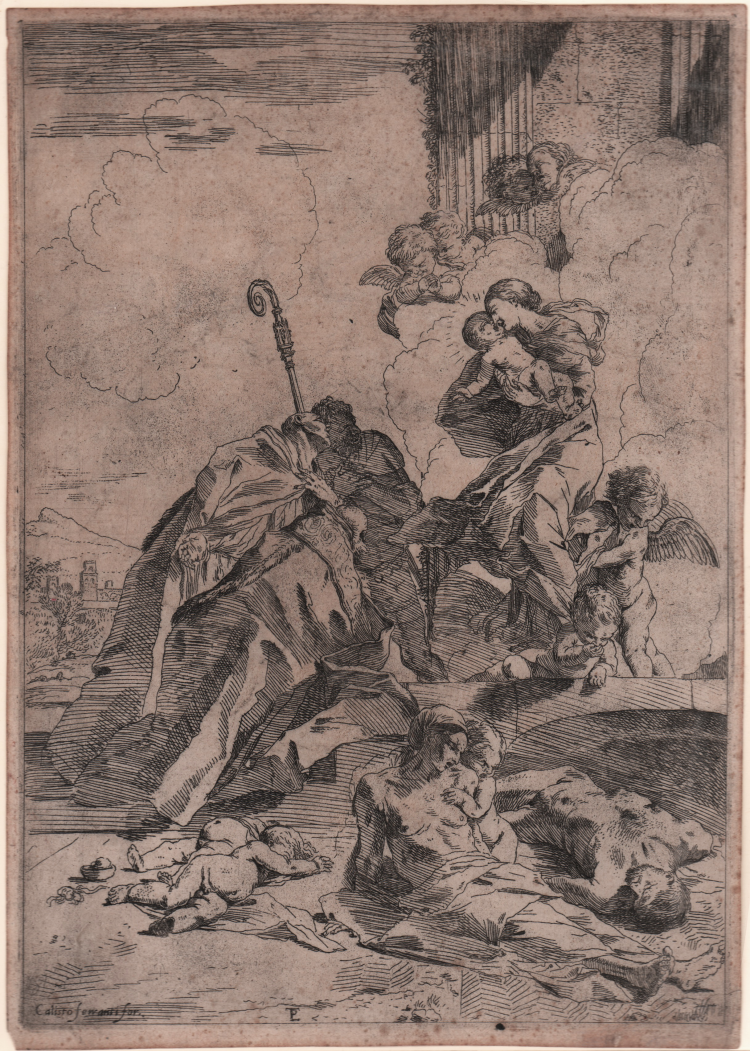




| Reference: | S5321 |
| Author | Pietro TESTA detto "Il Lucchesino" |
| Year: | 1630 ca. |
| Measures: | 200 x 285 mm |



| Reference: | S5321 |
| Author | Pietro TESTA detto "Il Lucchesino" |
| Year: | 1630 ca. |
| Measures: | 200 x 285 mm |
Etching, about 1630-31, signed at the lower centre.
A very fine impression of the second state of three with Callisto Ferrante's address; narrow margins, on laid paper, very light spotting, otherwise in very good conditions.
"In 1630 plague struck Lucca, reaching the height of its fury in the summer of 1631. The vignette of the towers of the Case dei Guinigi in Lucca, set against the hillsideto the left of this print, indicates that Testa had in mind the sufferings of his native city, not just the general horror of the plague that ravaged northern Italy and to which Poussin referred in his Plague of Ashdod of 1631. The figures to the left are then local saints, rather than Saints Nicholas and Roch, as Gori Gandellini and Bartsch proposed. Saint Martin appears in the armor of a Roman soldier and carriers a sword, as he does on the sculpture on the facade of the cathedral in Lucca, of which he is titular saint. The figure in the cope who holds a crozier is Saint Paulinus, firt bishop and patron saint of the city. The central figure may be Saint Thedore, Lucca's other bishop saint, whpse miraculous powers Testa celebrated in an altarpiece later in his career (...)
Testa returned to Lucca in 1632, but he had probably made this print in Rome when the plague was at its height. A date of 1630-31, cloese to the time of Testa's brief apprenticeship in Pietro da Cortona's studio, is thus proposed for this work, one of his most delicate compositions, the luminosity and perspectival originality of which have inspired more than one critic to compare it to the etchings of Tiepolo" E. Cropper, Pietro Testa, p.13 n. 7.
Pietro Testa was called Lucchesino for he was born in Lucca. There are but a few news about his apprenticeship in his hometown; for sure, he went to Rome in 1629 to study in the school of Domenichino first and then, towards the end of the year, he moved to the studio of his real master, Pietro da Cortona. His introvert temper caused him a lot of troubles; Cortona, in fact, was obliged to send him away due to his hostile and disdainful behaviour.
Testa went then to the house of his first patron, the famous collector Cassiano del Pozzo, and for him he realized his drawings from antiques. Maybe it was in this house that he met Nicolas Poussin who deeply influenced his art both in the neo-Venetian phase and the intellectual classicist one, from 1635.
His engravings though, about 40 pieces, have been considered, starting from Sandrart and Bladinucci, the most important graphic works of the Italian XVII century.
Bibliografia
T.I.B. 013; Bellini 8 II/II; Cropper, Pietro Testa, p. 13 n. 7.
Pietro TESTA detto "Il Lucchesino" (Lucca 1611 - Roma 1650)
|
Pietro Testa was called Lucchesino for he was born in Lucca. There are but a few news about his apprenticeship in his hometown; for sure, he went to Rome in 1629 to study in the school of Domenichino first and then, towards the end of the year, he moved to the studio of his real master, Pietro da Cortona. His introvert temper caused him a lot of troubles; Cortona, in fact, was obliged to send him away due to his hostile and disdainful behaviour.
Testa went then to the house of his first patron, the famous collector Cassiano del Pozzo, and for him he realized his drawings from antiques. Maybe it was in this house that he met Nicolas Poussin who deeply influenced his art both in the neo-Venetian phase and the intellectual classicist one, from 1635.
His engravings though, about 40 pieces, have been considered, starting from Sandrart and Bladinucci, the most important graphic works of the Italian XVII century.
His last production is characterized by classical and complex symbols and by the myths of Stoic philosophy, which he had followed all along his life. This pessimistic idea of life and the universal drama that humanity was living can be considered the main causes of his melacholy and sadness which led to commit suicide in 1650, when Testa threw himself down to the Tiber, near Lungara
|
Pietro TESTA detto "Il Lucchesino" (Lucca 1611 - Roma 1650)
|
Pietro Testa was called Lucchesino for he was born in Lucca. There are but a few news about his apprenticeship in his hometown; for sure, he went to Rome in 1629 to study in the school of Domenichino first and then, towards the end of the year, he moved to the studio of his real master, Pietro da Cortona. His introvert temper caused him a lot of troubles; Cortona, in fact, was obliged to send him away due to his hostile and disdainful behaviour.
Testa went then to the house of his first patron, the famous collector Cassiano del Pozzo, and for him he realized his drawings from antiques. Maybe it was in this house that he met Nicolas Poussin who deeply influenced his art both in the neo-Venetian phase and the intellectual classicist one, from 1635.
His engravings though, about 40 pieces, have been considered, starting from Sandrart and Bladinucci, the most important graphic works of the Italian XVII century.
His last production is characterized by classical and complex symbols and by the myths of Stoic philosophy, which he had followed all along his life. This pessimistic idea of life and the universal drama that humanity was living can be considered the main causes of his melacholy and sadness which led to commit suicide in 1650, when Testa threw himself down to the Tiber, near Lungara
|